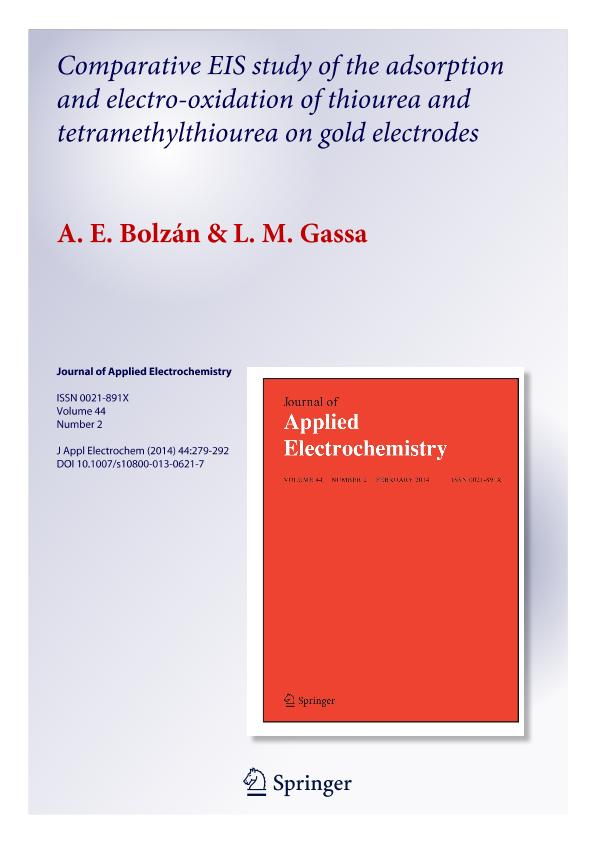Mostrar el registro sencillo del ítem
dc.contributor.author
Bolzán, Agustín Eduardo

dc.contributor.author
Gassa, Liliana Mabel

dc.date.available
2018-01-04T13:46:04Z
dc.date.issued
2014-02
dc.identifier.citation
Gassa, Liliana Mabel; Bolzán, Agustín Eduardo; Comparative EIS study of the adsorption and electro-oxidation of thiourea and tetramethylthiourea on gold electrodes; Springer; Journal of Applied Electrochemistry; 42; 2; 2-2014; 279-292
dc.identifier.issn
0021-891X
dc.identifier.uri
http://hdl.handle.net/11336/32276
dc.description.abstract
A comparative study of the electrochemical behaviour of thiourea (TU) and tetramethylthiourea (TMTU) on gold in sulphuric acid was performed using a gold rotating disc electrode. The electrochemical impedance spectra are interpreted through an equivalent circuit involving the electrolyte resistance, a constant phase element for the capacity double layer, a charge transfer resistance and, depending on the electrode potential, a second parallel impedance element whose interpretation depends on the potential region considered. Thus, for both thioureas, the Nyquist plots for E < −0.6 V (vs. MSE) exhibit a single capacitive time constant related to the adsorption of the molecule on the electrode surface. As E increases, the Nyquist plots exhibit a new time constant assigned to the formation of a soluble complex species. This time constant appears in the potential region also related to the electro-oxidation of the thioureas to the corresponding formamidinium disulphide. This means that these processes are coupled and, therefore, only one time constant can be observed. An inductive loop at low frequencies is associated with the pitting of the gold electrode for E ≥ −0.20 V, in agreement with SEM micrographs. The value of the corresponding charge transfer resistance decreases markedly with the electrode potential, indicating the increase in the rate of the electrochemical processes. Electrodissolution of gold results more importantly in the presence of TMTU. At potential values associated with the formation of the anodic oxide layer on gold, a negative resistance is recorded, indicating the passivation of the electrode surface. Eventually, at E > 0.6 V, the electrode surface passivation disappears and the Nyquist plots exhibit two strongly overlapped capacitive constants assigned to the oxide film growth at the monolayer level and the second electro-oxidation process of thioureas, the latter resulting in the formation of carbon dioxide and sulphate ions according to FTIRRAS data.
dc.format
application/pdf
dc.language.iso
eng
dc.publisher
Springer

dc.rights
info:eu-repo/semantics/openAccess
dc.rights.uri
https://creativecommons.org/licenses/by-nc-sa/2.5/ar/
dc.subject
Gold
dc.subject
Thiourea
dc.subject
Tetramethylthioruea
dc.subject
Eis
dc.subject
Electro-Oxidation
dc.subject
Electrodissolution
dc.subject.classification
Otras Ciencias Químicas

dc.subject.classification
Ciencias Químicas

dc.subject.classification
CIENCIAS NATURALES Y EXACTAS

dc.title
Comparative EIS study of the adsorption and electro-oxidation of thiourea and tetramethylthiourea on gold electrodes
dc.type
info:eu-repo/semantics/article
dc.type
info:ar-repo/semantics/artículo
dc.type
info:eu-repo/semantics/publishedVersion
dc.date.updated
2018-01-03T19:07:27Z
dc.journal.volume
42
dc.journal.number
2
dc.journal.pagination
279-292
dc.journal.pais
Alemania

dc.journal.ciudad
Berlin
dc.description.fil
Fil: Bolzán, Agustín Eduardo. Consejo Nacional de Investigaciones Científicas y Técnicas. Centro Científico Tecnológico Conicet - La Plata. Instituto de Investigaciones Fisicoquímicas Teóricas y Aplicadas. Universidad Nacional de La Plata. Facultad de Ciencias Exactas. Instituto de Investigaciones Fisicoquímicas Teóricas y Aplicadas; Argentina
dc.description.fil
Fil: Gassa, Liliana Mabel. Consejo Nacional de Investigaciones Científicas y Técnicas. Centro Científico Tecnológico Conicet - La Plata. Instituto de Investigaciones Fisicoquímicas Teóricas y Aplicadas. Universidad Nacional de La Plata. Facultad de Ciencias Exactas. Instituto de Investigaciones Fisicoquímicas Teóricas y Aplicadas; Argentina
dc.journal.title
Journal of Applied Electrochemistry

dc.relation.alternativeid
info:eu-repo/semantics/altIdentifier/doi/http://dx.doi.org/10.1007/s10800-013-0621-7
dc.relation.alternativeid
info:eu-repo/semantics/altIdentifier/url/https://link.springer.com/article/10.1007%2Fs10800-013-0621-7
Archivos asociados
